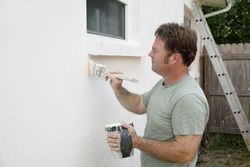What's the Difference Between Interior & Exterior Painting Products?

It’s often said that it’s what’s on the inside — not the outside — that counts, but when it comes to paint categories, both do. There are numerous differences between interior and exterior paint, and mixing the two up could result in some unpleasant consequences. Before you use up that old can where it doesn’t belong, consider the following comparison of interior and exterior painting products.
How Do Interior & Exterior Paint Differ?
To best understand how interior and exterior paint work, you’ll have to think about how they’re designed. For example, paint that’s meant to sit outdoors will be equipped to resist fading from the sun’s rays, as well as mold and mildew growth from humidity. Interior painting jobs will have to fight stains and hold up to cleaning measures.
As a solution to these differences in functionality, paint manufacturers use different resins in each of these categories. Essentially, resin is the substance that makes paint stick to the surface of your walls, baseboards, or ceilings. It’s separate from the pigment, which is only responsible for the paint’s coloring. Exterior paint requires a softer resin, while interior paint uses tougher resins to reduce scuffs and smears.
What Will Happen if I Switch Them Up?
 First and foremost, you may notice a difference in the aesthetic quality of the interior or exterior painting job if you use the wrong paint category, especially when it comes to texture. While interior paints might offer a glossy, satin finish to complement your interior design, an exterior paint can look rough and indelicate once indoors.
First and foremost, you may notice a difference in the aesthetic quality of the interior or exterior painting job if you use the wrong paint category, especially when it comes to texture. While interior paints might offer a glossy, satin finish to complement your interior design, an exterior paint can look rough and indelicate once indoors.
Aside from aesthetic, the resins used in exterior painting to reduce damage from the elements are known to outgas, or steadily release gas chemicals once applied. While the bulk of the outgassing will occur in the first 48 hours, it can go on in smaller quantities for years. Therefore, using this paint style inside your home could be dangerous to your family and pets.
Additionally, some exterior materials may require a certain type of paint to enable the transfer of moisture, such as brick. Using an interior paint on an outdoor brick wall could prevent the brick from breathing, or emitting moisture naturally, ruining your paint job and your home’s curb appeal.
If you’re looking for help with an interior or exterior painting job, leave it to the professionals at Art Evans & Sons Painting Contractors of Oxford, OH. This family-owned and-operated company has been refreshing properties for over seven decades, and they’d be proud to guide your home improvement in the right direction. For more information on their painting services, visit the website or call (513) 523-6425.
About the Business
Have a question? Ask the experts!
Send your question

